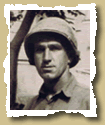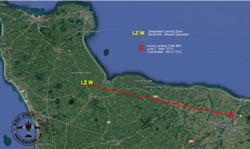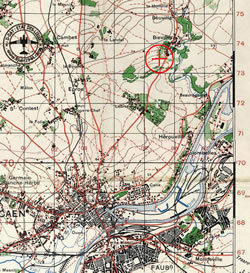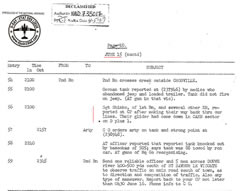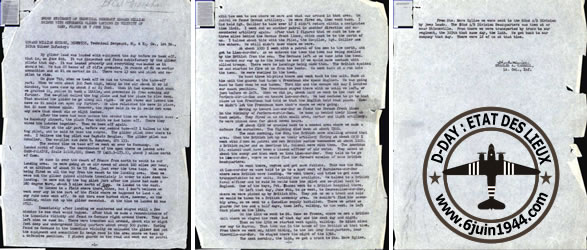| The Assault | Timeline | Maps | Men of D-Day | Photos |

|
SWORN STATEMENT OF TECHNICAL SERGEANT EDWARD WILLIAM My glider load was loaded with equipment the day before we took off, that is, on June 6th. It was inspected and found satisfactory by the glider pilots that day. It was loaded properly and everything was loaded as it should be. We had 22 boxes of AT rifle grenades, 36 rounds of 81 mm mortar ammunition and an 81 mm mortar in it. There were 13 men and pilot and co-pilot to ride. On June 7th, when we took off we had no trouble on the take-off part. When we were about 300 feet high, being in the air about 10 or 12 minutes, the nose came up about 2 or 2 ½ feet. When it had opened that much we grabbed it, pulled it back a little, and prevented it from opening any further. The co-pilot called the tug plane and had the plane to slow down. That enabled the glider to go along all right. We got ropes and lashed the nose so it could not open any further. We also relatched the nose in place, but it came undone again. However, the ropes held it so it could not open any more than about six or eight inches. After the nose had come undone
the second time we were brought back to Ramsbury Airport, the place
from which we had taken off. There they wired the latches together.
Then we took off again. The second time we took off we
went on over to Normandy. We landed north of Caen. The coordinates
of the spot where we landed are : CAEN-FALAISE, Scale 1:100,000,
Sheet 7F (405.5-173.5), about 3 miles north of Caen. We landed in a field were there were mines, but I don't believe we went over any in the part of the field where we happened to land – at any rate none went off. We cut thru some barbed wire, however, on the landing, which cut up the glider somewhat. At the time we landed it was 0713. Immediately after landing we
scattered and stayed still a few minutes to see what would happen.
After that we made a reconnaissance of the immediate vicinity and
found no Germans right around there. They had left when we came
in. There were trenches all around, about six or eight feet deep
and underground living quarters about every 500 yards. Having found
no Germans in the immediate vicinity we unloaded the glider and
put the equipment and ammunition in hedge rows in the area where
we took up a defensive position. I placed guards on the road and
went out on patrol with two mens to see where we were and what was
around in that area. On patrol we found German artillery. We were
fired on, then went back. I had told Sgt. Callier to take over if
I didn't return within a designated time limit. I went out on another
patrol in another direction and encountered artillery again. After
that I figured that we must be two or three miles behind the German
front lines, which must be to the north of us. I talked about this
with the Pilot, the co-pilot, Sgt ? Callier and the others.
We still didn't know where we were. We took three bicycles there and went back to the unit. Back at the unit the guards had taken a Frenchman who spoke English. He was going back to Caen when he was taken. Thru him and the escape kit map I located our exact position. The Frenchman stayed there with us until we left, or just before we left, When we did go, about 1400 we went to the east of Periers-sur-le-Dan and on toward Luc-sur-Mer. We had decided to go to that place as the Frenchman had told us that the English held that place. How we didn't let the Frenchman knew that's where we were going. Moving up toward Luc-sur-Mer we found the German front lines in the vicinity of Periers-sur-le-Dan. We came up behind their lines at that point. They fired on us with small arms, mortar and light artillery. We were pinned down for about seven hours. At about 2300 we crawled back to a wooded area where we made a defense for ourselves. The fighting died down at about 2300. The next morning, the 8th, the British were shelling around that area. When the British let up on their artillery firing at about 0930 I went with 2 men on patrol and met British marine commandos at about 1100. A British major and an American Lt. Colonel were with them. The American Lt. Colonel must have been a liaison officer of air corps. They asked us about the enemy and then went on into Lion-sur-Mer. They told us to go to Luc-sur-Mer, where we would find the forward echelon of some British headquarters. We went there, rested and got some rations. This was the 8th. At Luc-sur-Mer we were told to go to a spot west of Bernieres-sur-Mer where some British were landing. We went there, and tried to get some transportation to our unit. Nothing was available. We talked to a British Naval officer and he said he would take the pilot and co-pilot back to England. One of the boys, Pvt. Ibanez went to a British hospital there. We left that day, June 8th, to go west, to Courseulles-sur-Mer, where we were picked up by British Mps. They put us on a truck and said we would be taken to a British assembly area. We couldn't find the assembly area, so we went to a Canadian supply battalion. There we acted as guards for two and a half days, then left, walking, to the west. We left that place on the 11th. On the 11th we went to St. Come de Fresne, where we met a British unit where we stayed the rest of that day and the next day and night. Then on the 13th we started west again, walking. We hitch hiked our way to Bayeux. That town was in the hands of the British at that time. From there we went on, hitch hicking, to the 1st Army headquarters, near Vierville-sur-Mer. We stayed there the night of the 13th. The next morning, the 14th, we
got a truck to Ste. Mere Eglise. Edward W. Shimko (June 1944) Charles A. Carrell, Lt. Col., Inf.
|
| |
